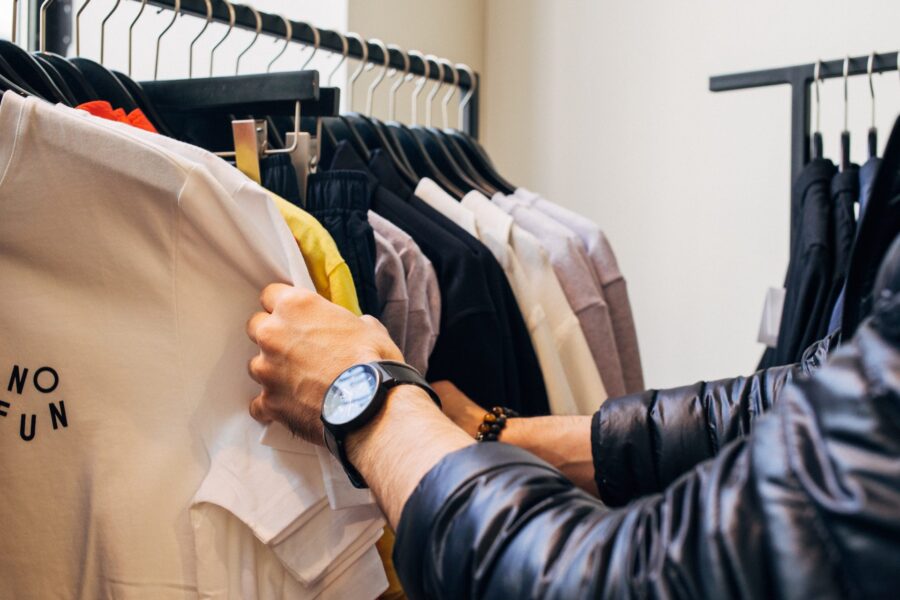
Virtual fitting room software with AR and AI is the next best alternative to physical stores. With many different kinds of virtual fitting room solutions on offer though, it can be hard to know which ones are the most feasible for your business. Let’s talk about the various approaches to developing such solutions.
Types of virtual try-on solutions
There are several different approaches for virtual try-on for various settings. Each approach provides for different business purposes and features and has its own pros and cons.
In-store virtual dressing solutions
Also known as smart mirrors, this solution shows a reflection of the user with overlaid augmented reality (AR) elements to show them as if they were wearing products of their choice, like clothing or accessories. A smart mirror could also include prices, color variations, stock availability, and other information that they might need to know.
Online virtual fitting room solutions
Especially important for ecommerce outlets and physical stores looking to expand online, virtual fitting room technologies can be extended to at-home experiences on mobile and desktop devices. This can either work through 3D rendering on digital mannequins, or through AR techniques.
When using digital mannequins, shoppers can specify dimensions and body types to get a better understanding of how products may look on them. AR can allow them to try on clothes in real-time and provide a more personalized experience.
Body sizing solutions
One of the greatest causes for skepticism and concern from shoppers is choosing a size for products. This is one of the most important advantages of in-person fitting rooms. However, other solutions do exist. For example, photo-based size recommendation solutions use customer images to calculate measurements with AI. With more powerful depth sensors being available in more modern smartphones than ever, this becomes even more feasible for many customers.
Apps with body measurements
These kinds of apps provide accurate measurements for users to help them with more personalized apparel shopping experiences. By tailoring online experiences to a user’s body type, ecommerce sites can increase sales, engagement, and customer loyalty.
There are some ready-made options available out there, but often times when you’re making and selling your own products, you’re going to need more flexibility than those solutions can provide.
A fundamental part of measuring bodies is pose estimation, detecting key body points and their positions. Body segmentation models create pixel masks of the human body and convert those pixels into measurement units. This can be done in 2D or 3D, depending on the project requirements.
2D pose estimation models aren’t as accurate as 3D methods, as 3D solutions incorporate depth into the model. To get a better understanding of measurements in the photos, body segmentation can take place through user images. However, the user should also provide their height to the application, as the app can use their height as a reference measurement and as the basis for measurement of other elements of the images.
There will always be some room for error. It’s a good idea to consider allowing the user to manually adjust some AI-generated measurements throughout the process to get more accurate results.
Apps with 3D models of clothes and a body
Another solution is to use a 3D model mannequin that can wear renders of clothes sold by your business. The model could be made with an entirely fictional character, or it could be created using images from the user themselves.
The resulting mannequin would be a 3D mesh, and models of clothes would be able to fit over the top of this mesh. Product renders may need to scale up and down. This is especially important if you want to give the user the power to adjust the body type, size, and height of the mannequin to better match their body type.
Apps based on latent diffusions
Another approach that can be used for virtual fitting room technology is generative AI. Specifically, latent diffusion can be used with an appropriate dataset of around 50 photos of particular products from different angles. Preprocessing is used to get masks and text descriptions. As the model is set up, connections are made between clothes and text descriptions. The input interface is composed of:
- A base picture where the clothes will be swapped
- The mask where the change occurs
- A text prompt that matches the clothes we want to add
Every application is different, so keep in mind that your goals, resources, limitations, and other factors will influence how successful latent diffusion will be in virtual fitting room applications.
Wrapping Up
With different ways to approach virtual fitting room technologies, it’s up to business leaders to decide which technique is best for their customers. AI and AR technologies are also constantly changing, so innovations create new possibilities with each passing day. The most important part is having a vision for what you want to achieve and partnering with experienced software engineers who understand your needs and help you realize that vision.

